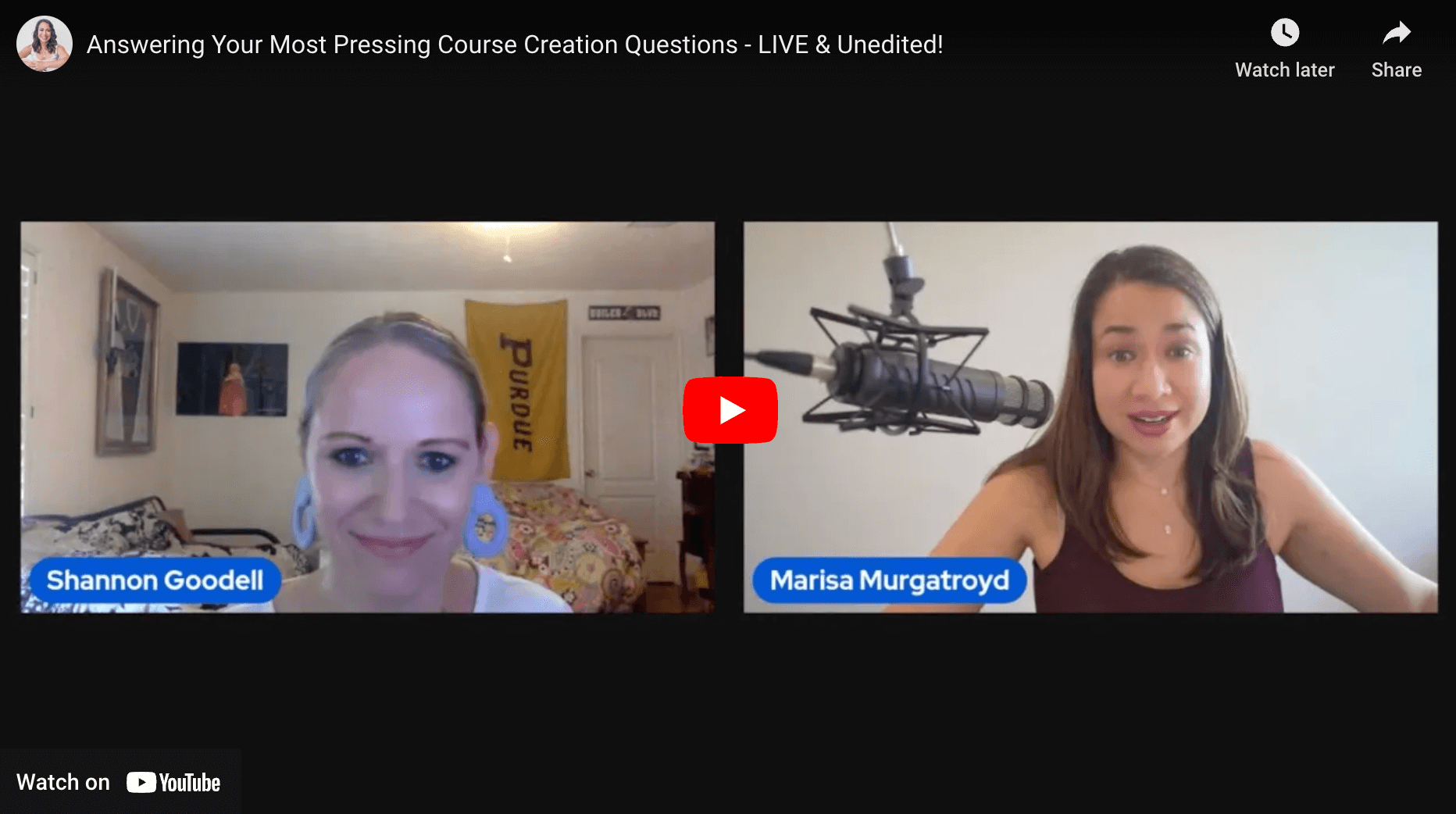If you’ve been thinking about creating an online course, chances are:
- You want to reach more people and have a positive impact on them by sharing your skills and knowledge.
- And you probably want to help them save time and money by teaching them lessons you learned the hard way.
But despite the passion you feel to help others, you may be dragging your feet.
You’ve got so much to share. Where would you even start?
From the topic to the tech to the marketing and everything in between, there are so many moving parts to consider that you feel overwhelmed and possibly, just STUCK…
I TOTALLY hear you.
In this post, I’ll guide you through everything you need to know (and nothing you don’t). So go grab a pen and paper to take notes and read on to learn how to get started creating an online program.
Now on to the steps!
- Pick Your Topic
- Scope Your Course
- Price It (Yes, Now Already)
- Plan It (Now? Yes, now!)
- Outline It
- Don’t Just Create a Course, Create an Experience
- Iterate to Awesome
- Market and Sell
- Scale Yourself Down to Scale It Up
- Share Your Genius — Create That Online Course — Now!
Pick Your Topic
Pick your topic. Easier said than done, right?
You’ve learned so much over the years. Through education, through experience and through the challenges life threw at you.
You’d cram it all into “The Ultimate Course” but the thought of sharing everything you know feels overwhelming… which may have tipped you off that it might be too overwhelming for students, too.
So, how do you decide on the topic for your first course?
Here are the three considerations you can use to narrow it down:
- Your audience: Who you want to work with
- The outcome: The transformation they want
- Your unique approach: Why you’re the one to get them to that transformation
Would You Dance With Just Anybody?
Many first-time course creators fall into the trap of selling to everybody because it’s scary to limit yourself to a smaller audience.
But ask yourself, would you dance with just anybody?
My guess is, you wouldn’t.
And you don’t want to dance with just anybody when you’re teaching, either.
You want to teach the people that are closest to your heart. The people going through what you experienced and who need your help to transform their lives.
They need to see themselves in you and your story, and they need to feel hopeful that they can change what needs to change.
To attract them, you need to get specific. So specific that the right students instantly know they’re in your audience and want to know what you have to say.
For example, don’t just teach moms; teach moms of preschoolers on the autism spectrum.
Not just high schoolers, but high schoolers who are applying to highly selective universities.
Honing in on Your First Course Topic
To hone in on a course topic people happily pay for, follow either a Demand First or a Problem First approach.
Demand First means you research what your audience wants, needs and already buys and then figure out how you can serve them better.
Demand First can be pretty utilitarian. Your heart may not be in it. But it’s less risky because you have proof people are already spending money on solutions — the outcome you offer.
Problem First starts from a problem you’ve experienced and solved or are still working to solve.
Problem First tends to be closer to your heart, but it’s riskier. You don’t know whether people would buy and testing for demand can be a challenge.
Let’s dig a little deeper into both.
The Good, the Bad and the Missing
Let’s say your audience is web programmers using JavaScript. Nice and specific.
(Don’t worry if technical stuff is not your thing. That’s not the point here.)
With Demand First, you’d research what JavaScript web programmers are already using, reading, buying, talking about and most of all: complaining about.
- What pains are they facing?
- What do they struggle with?
- What do they say about the tools they use?
- What questions come up again and again?
- What are they recommending to each other and why?
- What courses do they take? What do the reviews say?
To answer those questions, all you have to do is browse through forums, review sites, comments on blogs, Q&A sites, etc.
Your research will tell you what you can offer to fill in the gaps left by other programs and courses.
If you discover questions and problems not addressed by other books, tools or courses, you’ll have struck gold!
Opening Wallets Is Not as Easy as Opening Mouths
Impact-driven people tend to work Problem First.
To find out whether people will pay for your online course or program, you have to test your idea. You don’t want to invest significant time, effort and money creating something nobody wants or needs!
And that’s tricky.
When you ask someone whether they’d like a sports car, they’ll probably say “yes.” But you can’t treat that as a sign of demand. In all likelihood, they’ll disappear like snow melting in the hot sun when you bring up the price.
The best way to test whether there’s real demand is to get into real conversations around your topic (NOT “yes” or “no” conversations or sales conversations).
I call this the Chatterbox Campaign and all it takes is you and your ability to chat.
Your goal here is to see if whoever you’re chatting with — or someone they know — COULD be a potential customer.
And the great thing about this step is that you can get feedback on your online course or product right away — before you put all your time and money into creating it.
Because if you start to have a lot of conversations around your product and find that no one is interested or they don’t know anyone who could be interested… then you may have a dud on your hands OR it’s just not the right product-market fit. So you might discover it’s time to go back to the drawing board or reposition your product, program or course.
You’ll end up saving yourself so much time and money and frustration by Chatterboxing about your product BEFORE you build everything!
But, if you do find a lot of these conversations going in the right direction — people perking up, leaning in and wanting to learn more — you’ll know you’ve got something.
Here’s the thing — your ideal customers are everywhere and they’re looking for the solution you offer — which means you want to stay open to ALL the encounters that happen in your everyday life. Because every single moment and interaction is a unique and irreplaceable opportunity to make a difference in someone’s life — WHILE building your business.
I dive into the 3 main steps of Chatterboxing in my quick video tutorial.
Another reliable way to test whether there’s real demand is to set up a sales page and get people to click the “buy” button. They have to know their next step is to actually pay for the product you’re offering.
What you do after they click is up to you.
You can sent them to a “Thank You” page and offer to inform them when your course is available.
Or you could sell your course as a pre-order. Just be aware there are moral, ethical and legal issues in taking money before you can deliver.
You might consider setting up a “waitlist” page that just collects interested people’s name, email and maybe phone number. Then, contact them when your course is ready.
You’re Unique, but You’re Not an Exception
You’re unique. No question.
But you’re not an exception.
So in order to differentiate your online course from others on the market, you’ll have to show them what makes your course unique.
You stand out from the crowd by infusing your course with:
- Your take on the problem
- Your beliefs around the causes and the solution
- Your unique approach or method to get to that solution
You want to get clear on this as early as possible because it makes everything else so much easier.
It will:
- Clarify and direct what needs to be in your course and what doesn’t
- Inform the messaging for your marketing
- Help people decide whether they want to work with you
But you don’t have to figure out your idea alone… because my FREE Crack Your Course Idea Challenge is back for another incredible year!
Over 5 days, starting Wednesday, September 27th, I’m going to guide you through my proven process to practically guarantee your course will sell.
Whether you’re…
- just getting started and don’t have an idea yet
- have too many ideas and need help finding the right one
- have an idea you love that hasn’t yet translated into actual money in the bank
- or have a profitable idea and are ready to find your next one…
Join the FREE 5-Day Crack Your Course Idea Challenge!
Scope Your Course
Before you create and deliver your course, you need to decide what information will get them the results they want.
Bear in mind your students don’t want all the knowledge you have. They want just enough to achieve the result your course promises.
So don’t fill their backpacks to the point of overflowing. If they want more, they’ll come back for an advanced course or a coaching program. (And you’ll have a repeat customer!)
Let’s see how you keep the scope nice and tight.
Start From the Destination
To be effective, your course needs a single, concrete outcome.
Think of this as your “North Star.”
It’ll guide all decisions you still need to make about the course.
Avoid the Backroads
The best courses are laser-focused.
They cover everything that needs to be covered and nothing that doesn’t.
Think of it as sticking to the highways. The backroads can be beautiful and exciting, but it takes a lot longer to get where you want to go.
When in doubt, it’s good to err on the side of brevity. You can always add extra information in response to questions.
Gather Your Rocks
You want to fill your course like you’d fill a jar with rocks and pebbles. If you start with the pebbles, the rocks won’t fit. But if you start with the rocks, the pebbles will easily flow and fit around them.
So, with the outcome in mind, ask yourself what someone must know to achieve it.
What are the big ideas you need to cover?
A good way to answer that is to follow these steps:
- List the steps your students need to take them from where they are to ultimately… Mission Accomplished.
- Outline the minimum information they need to complete each step.
- Ruthlessly cut what looks more like a scenic back road than a highway.
Let’s look at an example: a course that shows dog owners how to teach their dogs to do a few cool tricks. The desired outcome is the dog doing these tricks consistently on command.
What do the owners need to know?
- The tricks they’ll be teaching their dog
- How to use positive reinforcement
- How to shape behavior
- How to break down tricks
- How to add a verbal cue
That’s it. Consider anything else to be “gravel” for this dog trick course. In other words — not a fit.
Time the Journey

With the big rocks in place, you can figure out how much time students will need to go through the course.
But be careful not to overestimate what students can absorb in a week.
It’s far less than you think… because chances are, you suffer from the curse of knowledge. You may not be able to imagine what it’s like to not know what it is you’re teaching or how hard it may be for a student to get their head around.
Let’s say you have six concepts to teach, plus the methods or techniques to apply them.
Six weeks for the core work sounds about right, because apart from going through the material, students need to work the exercises and assignments into their already busy lives.
Price It (Yes, Now Already)
It may feel strange to decide on a price when you’ve barely scratched the surface, but actually, the scope is all you need.
The outcome, the big ideas and the duration are what matter most.
Let me clarify.
Effort is Irrelevant
The amount of effort you put into creating your course is irrelevant when you’re deciding what to charge.
Of course, you want to recoup your development cost. And if you create physical course materials, you need to recoup their production costs as well. And let’s not forget the marketing and sales costs.
But none of these are how you determine the price of your course.
In fact, it’s the other way around.
The price you charge determines how fast you can recoup your costs and whether it’s even worth creating your course in the first place.
That’s precisely why you want to set the price before you spend any more effort creating it.
Your Self-Worth and Confidence Are Irrelevant
Whatever you think you’re worth, it doesn’t matter.
Harsh? Perhaps. But liberating.
Here’s why.
Whether you’re the world’s most confident person, or painfully insecure… whether you’re an expert or a beginner… don’t price your product based on your level of expertise.
Sure, successful and experienced people can charge more, but it has little to do with their sense of self-worth, confidence or expertise.
They charge more because they’ve proven that their customers achieve the outcome they promise. That’s how they became successful and experienced.
It’s also why social proof like customer testimonials are so powerful.
Deliverables Are Irrelevant
The value you bring isn’t in the course materials or design.
Just think for a moment what you would pay for the secrets to a fulfilling life or marriage. What would it be worth you to you to save your relationship and avoid the hassle, heartache, and financial drain of a divorce?
Would it matter if your PDF downloads had a basic or highly polished layout?
Would it matter if you received the answer in three or thirty PDFs?
Sure, a little polish can go a long way in shaping people’s perceptions, but achieving the outcome is how you get value for your money.
What Others Do and Charge Is Irrelevant
If you’ve already researched what other course creators charge for their programs, I’m willing to bet you were surprised by the broad range of prices you saw for things that looked similar on the surface.
The thing is, none of them are the same.
Every course is unique because the teachers are unique.
Comparing what’s already out there is comparing apples and oranges. Comparing yourself to them is no different.
Your course will be unique because you are. The value you bring to the table, your experience, and how you teach your subject are uniquely yours.
So, What Is Relevant?
Okay, so a lot of what you may have thought is relevant to pricing your course, isn’t.
But, what is relevant?
Three factors are paramount in setting your price.
Perceived Value
The first is what your customers think your course is worth to them. In other words, what value they put on the impact your course will have on their lives.
If you teach someone a solution to a problem they think is enormous, you can charge a lot more than if you solve something that’s only a tiny matter in their minds.
Duration
The second is the course’s duration. People expect to pay more for longer courses.
A three-month course by an industry expert for a desirable certification can command quite a bit more than a three-week course and certification by that same expert.
Signaling
Many people believe “You get what you pay for.”
That means you send an important signal about your course’s quality and value when you state your price.
Plan It (Now? Yes, now!)

How can you plan when you don’t yet know what lessons you’ll include or what needs to be in each?
All you have so far is that list with the big rocks from scoping the course!
That’s okay, because you only need to plan the overall timeline at this stage.
Let me explain.
Start in the Middle
To plan your course, its creation, marketing, and timing, you start in the middle: the day you’ll deliver the first session.
Don’t put it too far into the future. Maybe two or three months.
That may freak you out a bit, but it’s enough time to get on the playing field, because…
Don’t Create Everything in Advance!
I believe in getting it out there and improving through teaching the material and receiving feedback.
That means preparing only the bare necessities and teaching it live.
Because teaching live is the best way to sense how your students are tracking with you, and it allows you to adapt on the fly.
It also means you don’t have to worry about pre-recorded videos yet. Or completing all other material, like slides, worksheets, exercises, etc., before your first session.
It’s enough to have a week or two of lessons prepared.
The Three Things to Do in Advance
Before you teach the first lesson live, you need to:
- Create the outline
- Get the word out
- Prepare the lessons for the first week or two
1. Create the Outline
A good outline has several benefits:
- It clarifies your course’s path
- It helps everyone know what to expect
- It helps you stay focused and defer questions that jump the gun to a future lesson
You’ll be able to decide whether teaching and preparing the next lessons simultaneously is possible within your timeframe. That way, you can make adjustments before you announce the course to the world.
For example, you may have thought that you’d teach two lessons a week. But the outlining tells you that you’ll need about four days to prepare each lesson (I’m assuming you have other work to do as well).
That means your schedule is too tight.
When you make adjustments, change the teaching schedule, not the start date.
After all, if it’s too tight for you to create, it’s probably too tight for your students to absorb.
2. Prepare the Lessons for the First Week or Two
To stay ahead of the game, get the lessons for the first two weeks or so ready in advance.
This is another way to find out whether you’ll have enough time to teach and prepare lessons at the same time. You can make adjustments before you market and sell your course.
3. Get the Word Out
No matter how good your course is, you won’t get any students unless you get the word out.
You’ll need to create a marketing strategy for your program. Reach out to your network, run some ads, do some guest blogging –– whatever you prefer –– to get your course noticed and students registering.
1 to 3 weeks should be enough time to market your first course.
It’s long enough to get in front of enough people and short enough for them to take action without (much) delay.
Outline It
You need to plan your students’ journey from day one to Mission Accomplished and see whether everything fits within your chosen timeline.
That’s where outlining comes in. I find it’s best to outline at two different levels:
- Outlining the course as a whole — what you’ll teach
- Outlining each separate lesson — how you’ll teach it
Outlining What You’ll Teach

Outlining what you teach is where you finally get to crack open the big rocks you gathered as you scoped your course.
You take each big rock topic and work out what you need to teach about it.
Here are my tips for doing that:
- Go broad first. Choose the bare minimum information to teach about each big rock. What does your student absolutely NEED to know?Going deep first — getting into all the nitty-gritty details and inner workings — risks burdening your students with too much information.
- If you’re a detail-oriented person or you’re afraid of losing an idea, do a full brain dump about each rock, writing down every detail you can think of. It’ll keep your mind working smoothly and satisfy your detail-oriented side. When you’re done writing everything, you have to kill your darlings — take out everything that isn’t necessary (see next point).
- Focus on the 80% of situations at least 80% of your students are likely to encounter. The rest is unnecessary… or material for an advanced course.If your students need the other 20%, it’ll come up in Q&As or coaching sessions. You can either choose to address it in the group for everyone to see, or discuss it privately so you don’t distract the others.
- Mind maps grease the wheels in your brain. You can put each big rock on its own branch.If you’re able, try writing out what you’ll teach using pencil and paper. Working on paper aids in focus, memory, and reflection. It also gives you the freedom to add a bit of color or a shape to ideas that need more emphasis.
Now it’s time to create a logical structure for your whole course.
Keep in mind:
- Lessons are most effective when they’re short and teach just one concept and how to apply it
- Related topics and subtopics are easier to grasp when you put them together in coherent modules
- Help students make sense of it all by following an order that feels natural
Outlining How You’ll Teach a Lesson
When you have the broad outline for your course, you can outline and prepare (*) the lessons for the first week or two. (You’ll do the others while you teach the course.)
* You’ll find more details on preparing lessons in “Minimum Viable Preparation.”
Outlining a lesson is the same as outlining a course, but with concentration on a subtopic and details.
To teach effectively, there’s more to do than imparting essential information. That’s why I have devoted an entire section to creating an experience, not just a course.
Each lesson is an opportunity to create a dynamic, engaging experience.
The 4MAT model to create lesson plans helps you do that:
- Why
Why is what you’re about to teach crucial in their journey to their desired outcome? - What
Introduce the key concept or idea of this lesson. Focus on the big idea and clarify what’s essential about the lesson’s topic. - Practice
Show the method or technique in action by working through an example. Then assign practice exercises for your students to do on their own. - Adapt
Give your students assignments that let them apply what they’ve learned to their own situation. Learning to apply the lessons in their own lives brings them closer to the outcome.
Don’t Just Create a Course, Create an Experience
Bernice McCarthy created 4MAT to help teachers in classrooms. The online learning statistics show that dynamic and engaging teachers are needed online as well.
A mere 3% of students complete courses they signed up for.
That’s a massive problem. Why? Because those students don’t become repeat customers.
Without repeat customers, the Customer Lifetime Value (CLV or LTV) of your business would be limited and, more importantly, you’d have to spend a lot of time, energy, and money constantly trying to acquire new customers. .
How do you keep customers coming back?
Help your students savor the sweet taste of success by getting them to the finish line. They’ll turn into raving fans, and raving fans are likely to buy anything you create next.
How do you create raving fans?
By offering an experience, not just a course.
Experiences keep people engaged, eager for the next step, and filled with a sense of achievement.
If that sounds intimidating, don’t worry. I’ve got you covered.
Let’s look at two essentials for creating an engaging experience, and then I’ll introduce briefly you to the Experience Formula that takes them even further.
Stories Are Stickier Than Duct Tape
What was your history teacher like?
If you were unlucky, you had one that taught the dry facts.
Chances are you don’t remember much despite all the hours spent in history class or bent over your notes and books studying for tests.
If you were lucky, you had a teacher who told stories about the historical events you needed to memorize. Someone who engaged all your senses talking about what it was like to be a soldier in WWI, a slave in the cotton fields, a sailor at the Boston Tea Party, or Benjamin Franklin or Thomas Edison doing endless experiments before finally arriving at a solution.
Chances are, you remember those stories and the historical events as vividly as if it were yesterday.
That’s the power of storytelling.
It’s been used throughout history to entertain, capture imaginations and pass down wisdom.
So, flex your storytelling muscles and you’ll create a course that’ll enchant and inspire.
Games Are Natural Engagers

What’s the one thing you don’t have to convince anyone to do?
Play!
People of all ages love games. Racking up scores or points is addictive… for some, even more so when they compete with others.
(Pokemon Go, anyone?)
Statistics show that gamified courses and learning platforms are more effective than their traditional counterparts, both in terms of student results and revenue growth.
And the learning industry is catching on.
That’s why a few years ago, I twisted my husband’s arm to create Xperiencify, so I could give my own students a better experience, entice them to stay the course, and celebrate their results throughout the program (not just at the end).
The Experience Formula Ties it All Together
Xperiencify is based on the Experience Formula I teach in the Experience Product Masterclass.
But the Experience Formula is about more than gamification.
I use it to teach you everything you need to know about creating a course or program that’s designed to get students to “done,” so they’re likely to buy over and over and do your marketing for you by spreading the word about you and your program.
It has ten elements to engage from the moment people learn about what you offer:
- Mission
- Future Self
- Bird’s Eye View
- Constant Wins
- Normalizing Challenges
- Peak Emotional Experiences
- Feedback Loops
- Community
- Unstoppable Momentum
- Mission Accomplished
Now let’s look at how to satisfy the perfectionist in you.
Iterate to Awesome
No matter how often your inner perfectionist tells you your product isn’t good enough yet to launch –– and it will! –– they are wrong.
Because, quite frankly, you can’t know what perfect looks like in advance.
Despite your best efforts, things will come up.
- Things you forgot
- Things that confuse
- Things that distract
- Things where people get stuck
- Questions people ask you never considered
- And more…
What do you need to get as close to awesome as possible?
Feedback.
So you want to get out there early and often and ask for feedback so you can improve.
That means:
- Doing the minimum preparation needed
- Going back to basics for teaching
- Gathering feedback and analyzing responses
- Seeing the value in running one or more betas
1. Minimum Viable Preparation
Minimum viable preparation means preparing just the essentials. Such as:
- Creating an outline using 4MAT
- Designing the exercises and assignments
- Drafting lesson materials such as slides, speaker notes, cheat sheet summaries, templates, worksheets, etc.
That’s enough to teach in a classroom, and it’s enough to teach online, too.
2. Minimum Viable Teaching
While you haven’t nailed down what awesome looks like, you want to teach live using basic tech.
For example, Zoom, BlueJeans, or Google Meet for teaching, coaching, and live Q&As. And Facebook Groups (*) for offline Q&A, community, and sharing lesson materials.
The one non-negotiable requirement is to record everything, including saving the chat rolls.
* When you set the Facebook group’s type to “social learning” you’ll get a “Guides” section for your modules and lessons. A “files” section is always part of a Facebook group, and you can share your slides, exercises, and other materials through that.
3. Maximum Learning and Perfecting
To iterate to awesome:
- Welcome and solicit explicit feedback all the time
- Analyze the recordings and the chat rolls
- Analyze what happens in the Facebook group
You are doing this research to find where students were tracking with you, and where they were not. So, look for:
- Questions and comments
- Whether students answer each other’s questions and how (did they get it right?)
Use what you learned from your analysis to:
- Improve that lesson for the next time you run the course
- Adjust following lessons in the current iteration as needed (for this group)
You’ll want to run your course like this a couple of times, until you no longer see new relevant questions and comments coming up.
That’s how you’ll know you’ve reached awesome.
4. Beta Is the New Polish
Don’t be afraid to tell people that your course is “in beta.” And don’t think you’d need to lower your price because of that.
Beta programs offer just as much if not more value than a polished pre-recorded course.
Just think about it:
- Students get more access to you
- They can influence what and how you teach
They basically get to co-create the course with you. And as a result, they’ll love it even more.
It’s known as the Ikea effect: you value more what you’ve participated in creating.
Market and Sell

If you feel awkward when it comes to marketing and selling, you’re not alone!
Many people associate it with pushy, obnoxious salespeople and don’t want to be like them.
That’s a good thing unless you let it hold you back from marketing and selling your course. You’d deprive yourself of making the impact you want to make, and everyone who needs what you offer from learning about the opportunity.
So, let me rattle your cage a bit.
Everyone is a marketer and salesperson. Yes, even you.
Every time you attempt to convince someone of your ideas, you’re selling.
Every time you look for “buy-in” (see?) for a project, you’re selling.
Every time you try to get anyone to do something, you’re selling.
Marketing and selling your course is no different!
It’s not like you’d be twisting people’s arms to hand over their money and giving them a rickety rust bucket in return. You’re charging a fair price for the value you offer, and they’re free to say, “No, thanks.”
What to Focus On
The important thing for you to focus on is your message:
- How you describe your audience, the people who need what you have to offer. Know them as well as you know yourself, so you can use their language to speak to them.
- How you describe your offer. You want to hone in on the pain you soothe and the dream you make possible.
You don’t have to hype it up, but you don’t want to belittle it either!
How to Get the Word Out
Here are some strategies you can use to get the word out:
- Talk about what you do! I call it chatterboxing. Whenever you strike up a conversation with someone, be open to opportunities to naturally mention what you do.
- Join groups where your audience hangs out on LinkedIn or Facebook. Don’t focus on selling in these groups, just be helpful and make sure your profile has a link to what you offer and a short, specific call to action.
- Connect with people in these groups. Post helpful content; it’ll show up in the feed of new connections. Include a call to action like “comment or send me a DM if you want to hear more.” When they do, start a conversation and invite them to a short discovery call to see whether they’re a fit for your course (not everyone is, remember?)
- Use your existing network. Send people you haven’t connected with for some time a “Hi, how are you? Just checking in” type of message. In it describe, briefly, what you’re doing, and ask them to get in touch if they’re interested. And ask them to send anyone they know who might be interested your way, too.
Scale Yourself Down to Scale It Up
When you’ve adjusted your program enough to know what awesome looks like, you can scale down your direct involvement.
Here’s how you can do that:
Stop Teaching Live
With the content and the way you teach dialed in, you can pre-record lessons if you like.
But it’s not necessary.
You can also simply use the best recording of each lesson as teaching material.
The recordings of your live Q&A and coaching sessions are valuable material, too. You can make those available and limit the coaching you do live.
Switch Tech
You can stay with Facebook Groups to host your recordings and other materials, but there’s a drawback.
Facebook limits your ability to engage with and nurture your students. You’ll have to do it all manually, either yourself or by hiring and training someone to do it for you.
The other option is to switch to a platform that takes more off your plate.
There are plenty of membership site platforms to help you. When picking one, the one thing to remember is that it needs to work for you, not the other way around.
Build a Team
As your business grows, you’ll be working more in your business than on it.
That’s when you need a team if you want to grow even further.
But you want to start building your team before you even get to that point.
Because building a team takes time. Finding the right people to join your team takes time, and so does training them so they are equipped to do a good job.
You might start with hiring someone to help with your marketing and sales.
When 1:1 or small group coaching is part of your course or program, you can quickly become a bottleneck as the number of students increases. So the next people you want to hire and train are coaches to run the coaching and Q&A calls.
Having a team not only frees you up to work on your business, it also frees you up for higher-paying 1:1 work.
Share Your Genius — Create That Online Course — Now!
You’ve held back long enough.
You already helped many people tackle the challenges you grappled with yourself.
Now, it’s time to multiply your impact.
You’ve got the building blocks you need to create an online course. And while it will take some effort and time, it’ll also allow you to help many more people than you could ever do working with them individually.
So, share your genius, create your course, and be the Superhero your clients need. Then, watch them become the Superheroes of their own lives.
Thanks for reading! 🙂 Drop me a comment if you found this Guide valuable!
But before you go, I’ve got a HUGE announcement!
Doors to the Experience Product Masterclass are now OPEN!!!
This is your opportunity to change your life (and the lives of others)…
… with an Experience Product, the new type of high-impact online course that sells better, is more profitable, and makes students more successful.
The Experience Product Masterclass is your opportunity to work with me and my coaches directly, to launch your Experience Product quickly, easily & profitably.
(I only do this once a year, and NOW is your chance.)
Inside EPM you’re getting everything you need to virtually guarantee your success:
- A personal coach with unlimited email access (Free!)
- A collection of powerful AI-tools to help you create, build, market & launch (Free!)
- A completely done-for-you course or membership site build worth $5K (Free!)
- Plus an absolutely HUGE bonus that’s only available TODAY
Doors close at 11:59pm PT on October 19th… and you won’t be able to get in again until this time next year… so don’t miss out! Enroll today. 🙂
Love it? Hate it? Let me know...
-
clRIFICATION OF NEW SRUCTURE
-
One of my first impressions of you and your work showed you working on large sheets of paper strewn across your desk and on the floor. It was daunting but suggested you might know what you were talking about. My subsequent coursework “experiences” with you illuminated your teaching techniques making it all understandable with flow.
To date, Xperiencify has not provided me with the same feelings of comfort with the process and I am way behind. Today, I am revisiting it from the beginning with the anticipation that a personal reorganization of my attitude and a recognition of how diligent and frequent Murray has been in answering student questions, I will move from the 97% non-finishers to success.-
Hi Jim, thank you for your message! I would love to know how your revisit of Xperiencify went.
-
-
This is a very insightful message i have ever yearn for. This will take me miles ahead.
Thanks Marisa for this gift.-
Marisa is thrilled to hear you got so much out of this Guide, Emmanuel!
-
-
There are some fascinating closing dates in this article but I don’t know if I see all of them center to heart. There may be some validity but I’ll take hold opinion until I look into it further. Good article , thanks and we wish extra! Added to FeedBurner as effectively
-
I have recently started a website, the information you offer on this web site has helped me greatly. Thank you for all of your time & work.
-
So thrilled to hear that! Thank you for sharing!
-
-
hey there and thank you for your info – I have definitely picked up something new from right here. I did however expertise some technical issues using this website, since I experienced to reload the web site a lot of times previous to I could get it to load properly. I had been wondering if your web host is OK? Not that I’m complaining, but sluggish loading instances times will very frequently affect your placement in google and can damage your high quality score if advertising and marketing with Adwords. Anyway I’m adding this RSS to my e-mail and could look out for much more of your respective exciting content. Make sure you update this again very soon..
-
Yes, we did have some issues with our server but we are getting them ironed out. Thank you for sharing and for reading!
-
-
I always was concerned in this subject and still am, regards for posting.
-
Hope you found it helpful!
-


























Leave a Comment